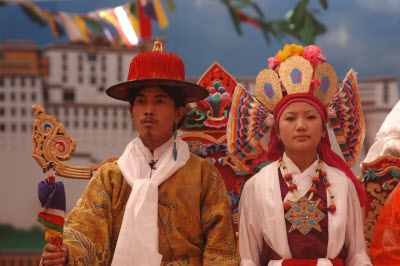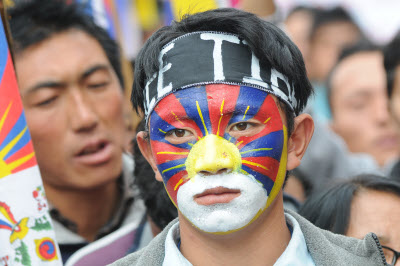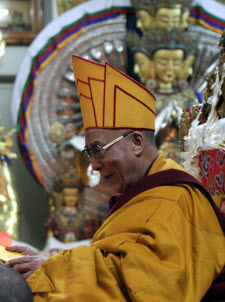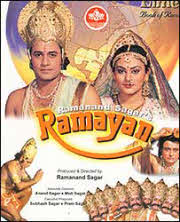by Tenzin Pema
[box]What does India mean to her and other Tibetans who live in India? Tenzin Pema shares her thoughts and experiences.[/box]Tenzin Pema works as a business journalist and is also on the advisory board of Global Tibetan Professionals Network. She also writes for Tibetan journals during her free time. To read more of Tenzin’s updates, visit her blog.
His Holiness the 14th Dalai Lama, the spiritual head of the Tibetan people, in a recent media interview referred to India as ‘my country.’ “I refer to India as my country because I have spent half of my life here… If you open my brain I am 100 percent Indian,” he had said. This statement by the Tibetan people’s beloved leader has earned much criticism in Chinese Communist press, as have his earlier references to himself as ‘son of India.’ Yet, despite the Chinese government’s attempts to mar the Tibetan leader in the eyes of his people in Tibet, by deliberately misreading his statements, there is not an iota of doubt that Tibetans in exile, after over fifty years of life in India, are no less Indian than their benevolent hosts.
Indeed, if you were to speak to or socialise with any Tibetan living in India, or even with many of those settled in other parts of the world, you will find that they are very much Indian – in the values and principles of life they uphold; in the myriad local tongues they speak; in the thorough delight they take in pleasing their palates with spicy Indian food; in their absolute worship of Bollywood and all its ‘heroes’ and ‘heroines’, to name among a few of their shared likes. Years of living in this beautiful country, with so many of her rich influences have shaped the lives of many a Tibetan life – from those in southern-most Bylakuppe, one among the many Tibetan refugee ‘camps’ situated near Mysore, to their friends and relatives in the picturesque North Indian-town of Dharamsala, or ‘Little Lhasa’ as it is so fondly referred to by tourists and writers, home to the Dalai Lama and the official seat of the Tibetan exile government.
There is also the more profound explanation of the centuries-old Tibetan connection with India. India’s influence on Tibet and Tibetan history began several hundred years ago when her scholars and religious masters travelled to the remote mountain kingdom to impart the teachings of Lord Buddha. Ever since, Tibet has shed its more aggressive and violent way of life, and instead adopted a more compassionate and peace-loving lifestyle. His Holiness the Dalai Lama so often during his teachings refers to this age-old relationship between India and Tibet, speaking with great reverence about the spiritual masters from Nalanda University. His Holiness has, on many occasions, said the relationship between India and Tibet is that of a ‘guru’ and ‘chela’ (teacher and disciple). “India is the guru and we are the reliable chelas. Since we have produced Buddhist scholars according to Nalanda tradition, we could be termed as reliable chelas for keeping the Nalanda tradition of Buddhism intact,” His Holiness has said. Thus, even Tibetan Buddhism, which has been so central to the lives of ordinary Tibetans for centuries together and which partly defines the very existence and popularity of the Tibetan cause to this day, is India’s most precious gift to Tibetans.

Artistes of the Tibetan Institute of Performing Arts in Mcleod Ganj, India, performing during the annual Shoton (Tibetan Opera) festival on 06 April 2010. Picture by Lobsang Wangyal
For Tibetan exiles today, India means more than the land that gave birth to their beloved Buddha Dharma, for to them, India is now a ‘home’ away from home. This, despite the fact that Tibetans, even though many have been born in India, live here with a stay permit that is processed through a document called Registration Certificate (RC), which is renewed every six months or every year. Among Tibetan exiles, there is a common and binding love for the people that shared their land with them. They never forget the fact that when the first generation Tibetan refugees followed their beloved leader into exile in 1959, India and her people gave them a new lease of life. Despite the harsh weather conditions, the unfamiliar diet, the alien language and most of all, the fear of having to start life anew, Tibetan life gradually took shape in almost every corner of India. And it was this country, which in allowing this consequentially, ensured the revival of Tibetan traditions, culture, language and religion.
Thanks to India’s timely support, the Tibetan way of life, which is fast facing complete annihilation in Chinese-occupied Tibet, has taken a much firmer root in the Tibetan people’s second home. Proof of this is evident in every visit you make to the different parts of the subcontinent – be it to Delhi’s Majnu-ka-Tilla, famed for its shopping complexes and for cheap Tibetan beer or chang; or to the South Indian Tibetan settlement of Bylakuppe with its charming cluster of ‘camps’ interspersed with golden-roofed monasteries; or the more well-known hill-top town of Dharamsala, a sure-fire stop for Western tourists hoping to catch a glimpse of or even meet with the Dalai Lama; or the roadsides of cities like Nagpur, Kolkata and Bangalore that are lined with rows of Tibetans selling woolen wear in makeshift shops; or even the holy Buddhist site of Bodh Gaya, whose landmark Mahabodhi Temple is speckled with maroon-robed monks and devout lay-Tibetans circling the temple in continuous circumambulation.

An exiled Tibetan youth paints his face with colours of the Tibetan flag on the 51st anniversary of the Tibetan uprising against Chinese rule in Tibet, in Mcleod Ganj, India, 10 March 2010. Picture by Lobsang Wangyal
In these sights lies another fact, the overpowering Tibetan presence in India, as the country continues, even till this day, to welcome Tibetans escaping the tyranny of Chinese rule in Tibet. A Tibetan friend, who currently lives in the United States, says “For a second-generation Tibetan exile like me, India is my first home.” Like many Tibetans, she says she is overwhelmed by gratitude each time her thoughts turn to India, where she received her much-needed foundation of modern-day education coupled with the traditional Tibetan upbringing, thus, allowing her and many others like her to strike the fine balance between the modern and the traditional.
Still, despite this seemingly fine balance, Tibetans are more Indian than they appear. While a north-Indian may not speak the local language of a south Indian state, a Tibetan can occasionally be sighted rattling off to the dozen with a local shopkeeper or haggling with an auto-rickshaw driver. Also, while some south Indians do not speak Hindi, Tibetans are so fluent in the language that they use it as if it were their ‘first’ language. This perhaps explains the originations of this running joke among the Tibetan people that Tibetans in exile speak ‘impure’ Tibetan; their Tibetan is ‘mixed’ with Hindi terms to define different things – like their choice of the word aloo for potato, and pura for all, instead of their lesser used respective Tibetan alternatives of shogo and tsangma.
So, it is no wonder then that another exile Tibetan, referring to His Holiness’ recent ‘100 percent Indian’ statement, said that in many ways, he too feels like his brain would reveal the same thing. The only difference, he was quick to add, would be that his head would be filled with Bollywood movies, Hindi songs and dances, Indian food, and memories of little Indian towns and villages that he has known as home.
“The only time I remember I’m a refugee is during the annual renewal of my Registration Certificate,” he said. “Otherwise, I feel so much at home in India.”
Lobsang Wangyal is a freelance photojournalist, and, what he calls, a small town impresario. He produces different art and entertainment events, and runs the Tibet Sun website.
Abhishek Madhukar is a photographer and journalist based in Dharamsala.






